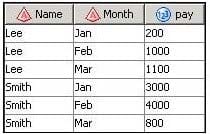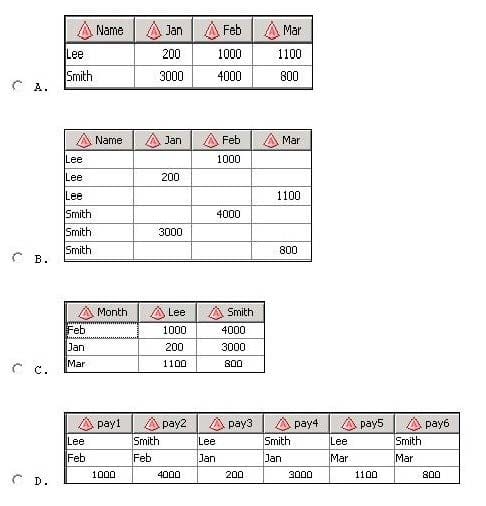A00-260 Online Practice Questions and Answers
Questions 4
When writing postcode in the Precode and Postcode tab of the Transpose transformation in SAS Data Integration Studio, which symbol allows you to reference the transformation output table regardless of the actual physical name for that target table?
A. andsyslast
B. syslast
C. andtarget
D. %target
Questions 5
Given the table below as a source table for the Transpose transformation in SAS Data Integration Studio:

In the Options tab in the Properties window for the Transpose transformation, if the columns are assigned as follows: Select columns to transpose (VAR statement): Payment Select a column for Output column names (ID statement): Month Select columns whose values define groups of records to transpose (BY statement): Name Which of the following tables is a possible resulting target table?

A. Exhibit A
B. Exhibit B
C. Exhibit C
D. Exhibit D
Questions 6
In SAS Data Integration Studio, which component allows the definition of job flows with dependencies between different jobs?
A. the deployment wizard of SAS Data Integration Studio
B. the Scheduling Manager plug-in in SAS Management Console
C. the Scheduling Server
D. the SAS DATA Step Batch Server
Questions 7
Which of the following are SAS Data Integration Studio job deployment types? (Choose two.)
A. a Web service
B. a SAS Stored Process
C. a Java Runtime Process
D. a SAS Information Map that is accessible in SAS Web Report Studio
Questions 8
A SAS Data Integration Studio job was successfully scheduled and the appropriate event for triggering it occurred. Which statement describes the situation correctly?
A. The scheduling server calls the SAS DATA Step Batch Server over the SAS Object Server which spawns the job, getting its source code from the deployment directory, and sends the results directly to the Schedule Manager plug-in of the SAS Management Console.
B. The scheduling server uses the command obtained from the SAS DATA Step Batch Server and the source code from the deployment directory to run the job. The results from the executing command are directly sent to the scheduling server.
C. The scheduling server uses the command from the deployed job in the deployment directory and executes it with the SAS DATA Step Batch Server which gets the source code from the Metadata Server. The results are sent back to the deployment directory.
D. The scheduling server uses the command obtained from the Schedule Manager, the source code from SAS DATA Step Batch Server and executes it. The results are directly sent to the scheduling server.
Questions 9
When using the Table Loader transformation in SAS Data Integration Studio to update an existing table containing indexes or constraints, which statement is true?
A. You can control the removal and/or creation of indexes and constraints in the target table only if you are using a Load style other than Replace.
B. You can control the removal and/or creation of indexes and constraints in the target table for all Load Styles.
C. If using the Append to Existing load style, indexes and constraints can be added but not removed.
D. For the Update/Insert load style it is possible to remove indexes not required for the Update/Insert processing, but no indexes can be added.
Questions 10
Which statements are true regarding columns when using SAS Data Integration Studio's New Tables wizard? 1. You can access metadata for any column from any table already registered in metadata but cannot change it. 2. You can access metadata for any column from any table already registered in metadata and can override the imported information. 3. You can define new columns for the table. 4. You cannot define new columns.
A. 1 and 2
B. 1 and 3
C. 2 and 3
D. 2 and 4
Questions 11
Within SAS Data Integration Studio, automatic mappings are disabled for a job. A transformation has defined source columns and defined target columns. One of the source columns, named COL1, is character with a length of 50. One of the target columns, named COL1, is also character but of length 25. What will happen if the COL1 columns are mapped?
A. The COL1 columns are successfully mapped, one-to-one, with no warnings.
B. The COL1 columns are not mapped because the lengths are different.
C. The COL1 columns are mapped but an expression is defined for the target COL1 that uses a generic specification of the LENGTH function.
D. The COL1 columns are successfully mapped, one-to-one, but a warning occurs.
Questions 12
Within SAS Data Integration Studio, how many inputs and outputs can be defined for a Generated transformation?
A. A transformation can have zero or more inputs and exactly one output.
B. A transformation needs at least one input and at least one output.
C. A transformation can have zero or more inputs and zero or more outputs.
D. A transformation needs at least one input and exactly one output.
Questions 13
In SAS Data Integration Studio, source table records and dimension table records are combined for output using which transformation?
A. Data Validation
B. Lookup
C. DataFlux IS Job
D. Table Loader
